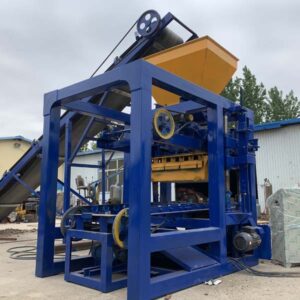
The world of construction has undergone significant transformations over the years, thanks to advancements in technology.
One notable innovation that has revolutionized the field is the cutting-edge block machine.
This machine has empowered masons and builders with the ability to craft precision-engineered blocks, leading to faster, more cost-effective, and sustainable construction solutions.
This essay delves into the evolution, features, benefits, and challenges associated with cutting-edge block machines, shedding light on their pivotal role in mastering modern masonry techniques.
Evolution of Cutting-Edge Block Machines
The evolution of block machines from manual processes to sophisticated, automated systems reflects the ongoing drive for efficiency and precision in construction.
Traditional brick and block-making methods were labor-intensive and time-consuming, often resulting in inconsistencies in size and quality.
The emergence of automated block machines marked a turning point, streamlining the production process and elevating the construction industry to new heights.
Early block machines were characterized by their basic automation, where manual intervention was still required to some extent.
However, with advancements in mechanical engineering, electronics, and computer control, the cutting-edge block machine was born.
These machines integrated hydraulic systems, precise sensors, and programmable logic controllers (PLCs) to create a seamless and efficient block production process.
Features and Capabilities
The cutting-edge block machine is equipped with a range of features that contribute to its efficiency and precision:
Automation and Consistency: Unlike traditional methods, which heavily relied on manual labor, cutting-edge block machines operate automatically, ensuring a consistent output of high-quality blocks.
This consistency is crucial for creating structurally sound buildings.
Customization: These machines can be programmed to produce a variety of block sizes, shapes, and textures, allowing builders to tailor their creations to specific architectural and design requirements.
Speed and Throughput: One of the most significant advantages of cutting-edge block machines is their ability to produce a large number of blocks in a short period.
This boost in productivity accelerates construction timelines and reduces overall project duration.
Precision Engineering: The integration of advanced sensors and controls ensures that each block is manufactured with precision, resulting in uniform dimensions and enhanced structural integrity.
Waste Reduction: By optimizing the use of materials and minimizing wastage, cutting-edge block machines contribute to more sustainable construction practices.
Benefits and Advantages
The adoption of cutting-edge block machines brings forth a multitude of benefits to the construction industry:
Time and Cost Savings: The accelerated block production process translates to reduced labor costs and faster project completion.
This efficiency leads to significant savings in both time and money.
Enhanced Quality: The precise engineering of blocks through these machines ensures that the end products meet strict quality standards, reducing the likelihood of defects and minimizing maintenance needs.
Design Flexibility: Builders and architects can experiment with a wide range of designs and patterns, giving rise to more innovative and aesthetically pleasing structures.
Reduced Environmental Impact: The reduction in material wastage and the potential for incorporating sustainable materials contribute to a more environmentally friendly construction process.
Safety Improvements: The automated nature of cutting-edge block machines reduces the physical strain on workers, promoting a safer and healthier working environment.
Challenges and Future Directions
While cutting-edge block machines offer numerous advantages, certain challenges must be addressed:
Initial Investment: The acquisition and setup costs of these advanced machines can be substantial, potentially posing a barrier for smaller construction firms.
Maintenance and Training: Proper training and ongoing maintenance are essential for optimal machine performance.
Skilled technicians and operators are required to ensure smooth operations.
Material Compatibility: Different types of construction materials require adjustments to machine settings, and achieving compatibility with a variety of materials remains a challenge.
The future of cutting-edge block machines is promising, with ongoing research and innovation focusing on overcoming these challenges:
Affordability and Accessibility: Efforts are being made to develop cost-effective models that cater to a broader range of construction companies, making this technology more accessible.
Advanced Materials: Innovations in construction materials, such as reinforced concrete blocks and environmentally friendly alternatives, are likely to be incorporated into the block-making process.
Automation and AI: The integration of artificial intelligence and automation technologies will further enhance the efficiency and predictive maintenance capabilities of these machines.
Global Reach: As technology spreads, cutting-edge block machines could contribute to addressing housing shortages and infrastructure needs in developing countries.
The cutting-edge block machine has emerged as a pivotal tool in the construction industry, enabling builders to master masonry techniques with unprecedented efficiency and precision.
Through a combination of automation, customization, and sustainability, these machines have transformed the way buildings are created.
While challenges remain, ongoing innovations are poised to overcome these obstacles, paving the way for a future where construction is faster, more flexible, and more environmentally conscious.
As we continue to push the boundaries of construction technology, the cutting-edge block machine stands as a testament to human ingenuity and its potential to shape the world around us.
